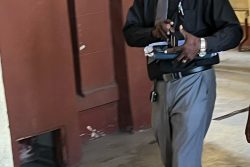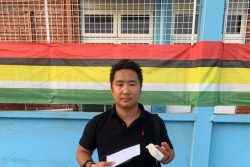In addition to drastically cutting the cost of production, boosting sugar yields and expanding the range of value-added sweeteners among other measures, GuySuCo can sell additional cogenerated power to the national grid as a means of returning to profitability, according to its former Chairman Vic Oditt.
In a recent presentation at a seminar at Moray House and encapsulated in a letter in yesterday’s Sunday Stabroek, Oditt also said that GuySuCo should not be characterized as bankrupt as its convertible assets are far greater than its debt.
Oditt, Chairman of GuySuCo from 1993 to 2003, also contended that GuySuCo had to get back to basics and one way of doing this is reviving its cane breeding programme for high yielding varieties. Adverting to the adage `sugar is produced in the field, the factory only extracts it’, Oditt said this is still very applicable as the sugar yields in 2014 were only 50 to 60% of those achieved 10 years ago.
Privatisation-based husbandry systems must also be introduced where gangs of workers self-manage plots and are paid incentives based on increased yields. He said that this system was successfully tried at Uitvlugt on the West Demerara in 2001-2002, when 10 workers were allocated 100 hectares and production jumped by 30% while the cost of production was reduced by 50%. He said that this should be tried on all estates and implemented once similar results are realized.

He contended that management should work closely with field staff to ensure minimum burning to grinding time, maximum poll in cane, optimal utilization of factory capacity, all of which result in good tonnes cane to tonnes sugar (TC/TS) conversion.
A Commission of Inquiry into GuySuCo set up by the APNU+AFC government will see a report being presented later this month. A number of persons and experts testified before it.
Oditt argued that cogeneration of power from bagasse can be a major profit centre for GuySuCo and suggested that the Government of India or/and the Caribbean Development Bank (CDB) should be approached to finance the acquisition and installation of cogeneration units (high pressure boilers and turbines) for the industry’s factories, by May-June 2016. He said that CDB President Dr Warren Smith did say recently that grant funds are available for alternative energy projects, such as these.
Oditt said that in India and many other sugar producing countries, sugar is now a by-product of the factories, since their main source of revenue is selling power to the grid.
He pointed out that GuySuCo has the unique advantage of having two crops per year and its factories are well situated to link to the grid. GuySuCo’s factories would therefore be in a good position to export over 50 MW of continuous power to GPL’s grid from cogeneration, thus earning significant revenue while saving foreign exchange.
He said that of the $82 billion GuySuCo debt that was recently highlighted, $25 billion is for the Skeldon sugar modernization project and $26 billion is an accounting provision for the payment of pensions when employees reach the age of 60.
Arguing that returning GuySuCo to viability depends on production, profitability and productivity (3P’s), Oditt said that human resource strategies must have the objective of reducing labour costs from 60% to 40% of total operational costs within 5 years. To achieve this, an agreement must be reached with the trade unions to review current practices, to identify those considered obsolete or which detract from the 3P’s and secure their support for amendment or removal. GuySuCo’s labour cost has been seen as a major impediment to profitability.
Additional value-added sugar products should be pursued to go with the Demerara Gold brand, Oditt said, noting that Mauritius produces 10 value-added sugar products. Revenues can also be improved by converting more bagged sugar to packaged sugar, which has a minimum net premium of US$100 per tonne, he stated. He also urged that the Demerara Gold trademark registration be pursued for North America.
Oditt added that GuySuCo must use its geographical location to locate more regional markets, since it can ship smaller tonnages on a regular basis at a premium compared to the large tonnages to be ordered for world market price.
Contending that GuySuCo’s 3P’s have been compromised by flawed political policies, political interference and mismanagement, Oditt noted that the cost of production during 2002-04 was US$0.16 per lb, while production averaged 320,000 metric tonnes. The current cost of production is around US$0.40 per lb and annual production has been around 220,000 metric tonnes in recent years.
The former GuySuCo chairman also cited the sale of GuySuCo land and said that future sales should be at commercial values. He said that the Government of Guyana had transferred thousands of acres of prime GuySuCo lands on the East Bank of Demerara and the East Coast of Demerara to developers “who are making billions while GuySuCo gets nothing”.
A large amount of these transfers had been made by the PPP/C government to housing developers.
Oditt also recommended that the financial support from the government to GuySuCo should be treated as a separate fund, either to expand share capital or to be converted into a loan to be repaid over 20 years. He noted that GuySuCo had paid a sugar levy of approximately $5 billion a year during 1976-1998, a significant percentage of the national budget during that time.








